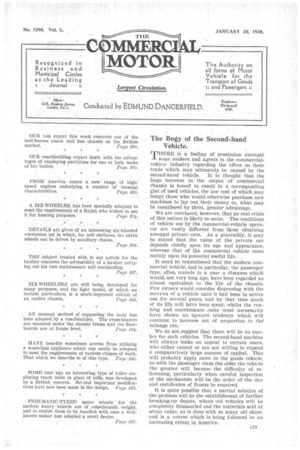The Bogy of .the Second-hand Vehicle.
Page 39

If you've noticed an error in this article please click here to report it so we can fix it.
THERE is a feeling of pessimism amongst —I— sow makers and agents in the commercialvehicle industry regarding the effect on their trade which may ultimately be caused by the second-hand vehicle. It is thought that the huge increase in the output of ;commercial chassis is bound to result in a corresponding glut of used vehicles, the low cost of which may tempt those who would otherwise purchase new machines to lay out their money to, what may be considered by them, greater, advantage.
We are convinced, however, that no real crisis of this nature is likely to occur. The conditions of vehicle use by the commercial-vehicle operator are vastly different from -those obtaining ainongst private cars. As a generality, it may be stated that the value of the private car depends chiefly upon its age and appearance, whereas that of the commercial vehicle rests mainly upon its potential useful life.
It must be remembered that the modern commercial vehicle, and in particular, the passenger type, often travels in a year a distance which would, not very long ago, have been regarded as almost equivalent to the life of the chassis. Few owners would consider dispensing with the services of a vehicle until it had been in active use for several years, and by that time much of its life will have been spent, whilst the running and maintenance costs must necessarily have shown an upward tendency which will continue to increase out of proportion to the mileage run.
We do not suggest that there will be no market for such vehicles. The second-hand machine will always make an appeal to certain users, who either cannot or are not willing to expend a comparatively large amount of capital. This will probably apply more to the goods vehicle, as with the passenger class the older the vehicle the greater will become the difficulty of relicensing?, particularly when careful inspection of the mechanism will be the order of the day and certificates of fitness be required.
It is quite possible that a partial solution of the problem will be the establishment of further breaking-up depots, where old vehicles will be completely dismantled and the materials sold at scrap value, as is done with so many old ships, and is a course which is being followed to an increasing extent in America.












































































































